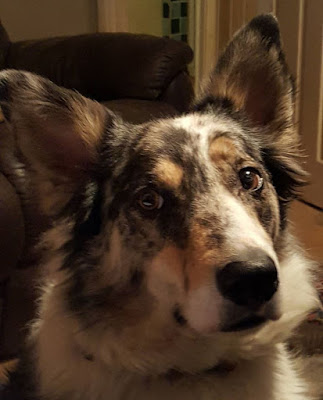 |
| What emotions might this dog be feeling? |
The relationship between humans and dogs stretches back thousands of years. We are continually finding new evidence of just how far back this amazing partnership goes, although we may never know for sure exactly how and when the first dogs and guardians came together. For much of this time together the relationship has seen two distinct levels – humans at the top (as our species considers us to be in so many ways) and the dogs beneath, the lesser part of the combination.
We don’t have to look back very far to find when many people thought dogs could not feel emotion, or at least only a few very basic emotions. To say anything to the contrary meant opening yourself up to accusations of anthropomorphism. Of course, many of us still positively stated what we knew to be true – that dogs have feelings too. I’ve lost count of how many times the word anthropomorphising has come in my direction, but it doesn’t bother me. I do sometimes mutter under my breath that the dogs around me have a better-tuned and more capable emotional capacity than the ignorant people accusing me of being a woolly and soft dog anthropomorphist!
 |
| It doesn't bother me - it's like water off a duck's back! |
We're Learning More About Canine Emotions
Thankfully, as time passes and research continues, our concept of the emotional capacity of dogs is better informed. Some concrete evidence giving a basis to this wider knowledge comes from the work of Gregory Berns, a professor of Neuroeconomics and Psychology at Emory University. His Dogs Project has trained a number of dogs (using only positive reinforcement, reward-based methods) to wear ear protection and lay completely still for extended periods in an MRI machine. This allows the dogs’ brains to be scanned while they are awake (a functional MRI or fMRI) and so see the activity going on in the brain in real time. See the different areas of the brain lighting up as they respond to stimuli.
In an interview for National Geographic in 2017, Berns said, “Scientists find it hard to accept the idea that animals have feelings. Most people who live with dogs understand this intuitively. The confusion comes because we have language and can label those feelings. We have words for things like love, fear, sadness, or guilt. Everything we started doing to elicit positive emotions showed that dogs had corresponding parts of their brains to humans.”
Dogs don’t experience all of the emotions that we do. They do feel emotions like sadness, joy, and fear. The common equivalence that we see mentioned is that the emotional development of the dog sits at roughly the same as a human toddler. We do know that dogs don’t experience guilt – what humans perceive as ‘guilty behaviour’ when they come home to find something destroyed or that the dog has toileted in the house is appeasement. The dog doesn’t understand why their human is angry when they come home, they certainly don’t relate it to something that occurred some time ago. However, they do know that their human often scolds them just after stepping through the door and so they use the language of appeasement in an attempt to avoid the scolding.
How Reactive Dogs Aid Understanding
A friend made an observation on a thread in a Facebook group recently that really struck a chord with me. What she said was that we guardians of reactive dogs understand the importance of recognising canine emotions and considering those emotions when training or just living with our dogs.
Those of us who share our lives with these complex dogs become highly attuned to the signs of fear and stress in our dogs. Because of our constant close observation of our dogs to pick up the earliest signs of stress, we pick up their other emotions as well. We can tell more easily when they’re happy, when they’re unsure, when they are happy to just relax and snooze for a while.
Why is understanding and reading the emotions a dog is feeling at a specific moment so important?
Behaviour doesn’t take place in a vacuum. It’s not something that ‘just happens’ at some point. The external behaviours that dogs display are a direct reflection of their internal state at that time. This includes the emotions they are feeling. Find the emotion that the dog is feeling and we can better understand the behaviours they are showing.
Understanding Emotions: Not Just for Reactive Dogs
The importance of considering how our dogs are feeling cannot be over-emphasised. Dogs are not ‘stubborn’; any lack of obedience isn’t to ‘show us up’ or to try to be the boss of us. When we cue our dogs to take an action and they don’t, there are always reasons for that failure.
- We haven’t taught the cue correctly and the dog is confused or has no idea what we’re asking.
- We haven’t proofed the cue correctly by introducing it in a range of locations and with increasing levels of distraction.
- Our dog is over aroused, and is stressed (it’s important to remember that over arousal can come through play as well as fear).
- Our dog is feeling unwell or in pain, meaning that they would feel uncomfortable or vulnerable taking that action.
A Change is Coming!
An acronym that I have seen pop up on Facebook recently is brilliant at highlighting the way we need to understand our dogs’ emotions. There is a fabulous Facebook group called Dog Centred Care, started by Andrew Hale, and it’s really working on educating people on the need to put the dog at the front and centre of our minds, rather than the dog fitting in to the human ideals and perceptions. It’s about letting dogs be dogs, act like dogs, and us understanding them as dogs. If you haven’t found the group yet, I really recommend checking it out. As my friend mentioned earlier says, it’s a breath of fresh air.
 |
| Not often I get to think about cake while talking about canine emotions! |
C.A.K.E. We all love cake, right? I know I do. This is a very special cake.
- C - Compassion
- A - Awareness
- K - Knowledge
- E - Empathy
Compassion means we view the situation without making judgements and by focusing on the needs of the other rather than our own. It means caring about others (and I'm including the need to have compassion and care for the humans involved as well as the dogs).
Awareness refers to the need for careful observations, which is perhaps one of the main reasons that reactive dog guardians are so excellent at spotting emotions and identifying the needs that come with those feelings.
Knowledge is something that we need to accumulate. We all have our own personal experiences that inform us to a certain extent. To gather true knowledge we must be prepared to learn, either in terms of deliberate study or in listening to and learning from the experiences of others. There are so many benefits to having a network, people with whom to share our experiences and knowledge and gather more from them. This is one of the great uses for social media. To create and increase our networks. Our canine-related communities can now be global and encompass a massive range of different experiences and backgrounds in the conversations available to us.
 |
| There's a whole world of experience we can learn from. |
Empathy is the cornerstone of living with a reactive dog. When we understand what is going on in the body and mind of the reactive dog, we can then have empathy for them. We can look at the situation, the world, from their perspective and see the things that are causing them to struggle.
C.A.K.E. For All, Human and Canine
Just as much as we do with reactive dogs, we should apply the same thought and care to all dogs who are finding something in their world difficult at that time.
This may be a puppy who is tentative about the big wide world. An adolescent caught up in that crazy whirlwind of hormones that can make for a difficult time for all concerned. An older dog who is feeling unwell, or a dog who has had a frightening experience. Equally, we must also apply these principles to the humans in the situation.
It can be frustrating to see people who are treating their dogs differently to us, who are using outdated methods that we now know are detrimental to the dogs. Often these people simply don’t know any better. They are working from bad information, poor advice, often from a trainer who uses those outdated techniques, or sadly the popular TV trainers who are so popular despite their aversive methods and lack of understanding of the needs of dogs.
Being judgemental (however angry or upset we may be at what has been happening to the dog) helps nobody as it can cause the other person to dig in their heels, often through embarrassment. These people need compassion and empathy as well, because the cognitive dissonance that comes with realising you have been mistaken for a long time is a very unpleasant feeling. Especially when realising that the mistakes made have resulted in fear and anxiety for our dogs.
I’ve mentioned before that I’m a crossover trainer and I know that feeling of guilt all too well, which makes me predisposed to be kind in my dealings with these people. (If they double down and refuse to listen, however, all bets are off!)
 |
| My beautiful catalyst for change 😍 He's taught me a lot about canine emotions. |
If you would like to learn more about understanding what goes in in a reactive dog, physically and physiologically, check out my book ‘Understanding Reactive Dogs: Why Dogs React & How to Help’ available as an eBook, paperback (at Amazon), and audiobook – all can be found through the above link.
Love this...
ReplyDelete